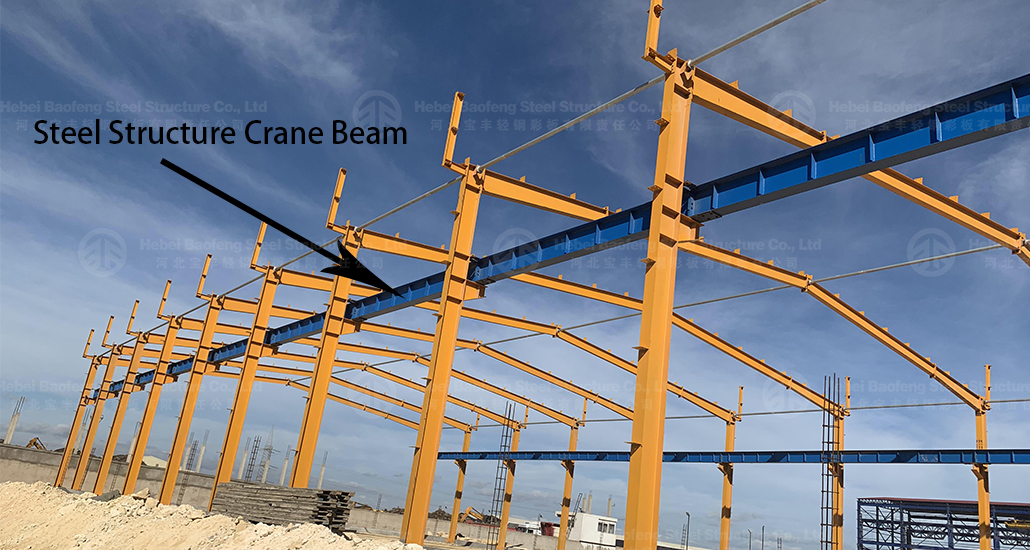
What is a Steel Structure Crane Beam?
A steel structure crane beam, often simply called a crane runway beam or crane girder, is a specifically designed horizontal structural member that forms the runway for an overhead traveling bridge crane or gantry crane. It is the critical component that directly supports the crane and its load, allowing the crane to move along the length of an industrial building, such as a factory, warehouse, or workshop.
In essence, it's the "track" or "rail" that the crane wheels run on, but it's much more than just a rail—it's a robust, integrated beam system designed to handle immense dynamic forces.
Key Characteristics and Design Features
1.
Material: Made from high-strength rolled steel sections (like I-beams) or, more commonly, built-up sections that are welded together from steel plates. Built-up beams are used for heavier cranes as they can be customized for strength and depth.
2.
Function: Its primary job is to:
Support Vertical Loads: Carry the weight of the crane itself plus the maximum hoisted load.
Resist Horizontal Forces: Absorb lateral thrusts from the crane accelerating, decelerating, or traversing sideways (crabbing), and longitudinal forces from the crane's travel along the runway.
3.
Key Components of a Crane Runway System:
Beam/Girder: The main load-bearing element.
Crane Rail: A hardened steel rail (e.g., AISC KR, or railroad rail like ASCE) that is securely fastened to the top flange of the beam. This provides a smooth, wear-resistant surface for the crane wheels.
Rail Clips/Clamps: Hardware used to attach the rail to the beam's flange, preventing movement.
Bracing/Stiffeners: Vertical stiffeners are often welded to the web of the beam to prevent web buckling under the concentrated loads from the crane wheels. Horizontal bracing between parallel crane beams is also crucial to maintain alignment and resist lateral forces.
Types of Crane Beam Systems
There are two main types, distinguished by how they are supported:
1.
Top-Running Crane Beams:
The crane beams are supported by the main building columns or separate crane columns.
The crane rides on top of the beams.
This design is used for the heaviest loads and highest capacities, as it provides greater hook height and superior stability.
2.
Under-Running Crane Beams (Underhung):
The crane beams are suspended from or supported by the roof structure's rafters or ceiling.
The crane hangs from and runs along the bottom flange of the beam.
This system is used for lighter to medium-duty cranes and is ideal where floor space is limited, as it doesn't require massive support columns.
Why is it a Specialized Structural Element?
A crane beam is not a standard floor beam. It is subject to unique and severe loading conditions that require specialized engineering:
High-Cycle Fatigue: Cranes are in constant, repetitive motion, causing millions of load cycles over their lifespan. The design must account for potential metal fatigue.
Dynamic and Impact Loads: The loads are not static. They include impact from the crane wheels hitting rail joints, sudden starts/stops, and the swinging of the lifted load. Design codes specify impact factors (e.g., 25% vertical impact) that must be added to the static load.
Concentrated Loads: The force from the crane wheels is a highly concentrated point load moving along the beam, creating maximum stress at specific points.
Biaxial Bending: The beam experiences significant bending about its strong axis (vertical load) and its weak axis (lateral forces).
Wear and Tear: The surface where the wheel contacts the rail is subject to constant abrasion and must be designed for durability.
Summary
In short, a steel structure crane beam is a heavy-duty, engineered steel beam that serves as the dedicated support track for an overhead crane. Its design is critical for safety and performance, as it must withstand the intense dynamic, cyclic, and multi-directional forces generated by a moving crane and its load within an industrial facility.

Catégories
dernier blog
Mots clés
© droits dauteur: 2025 Hebei Baofeng Steel Structure CO.,LTD Tous les droits sont réservés.

IPv6 réseau pris en charge